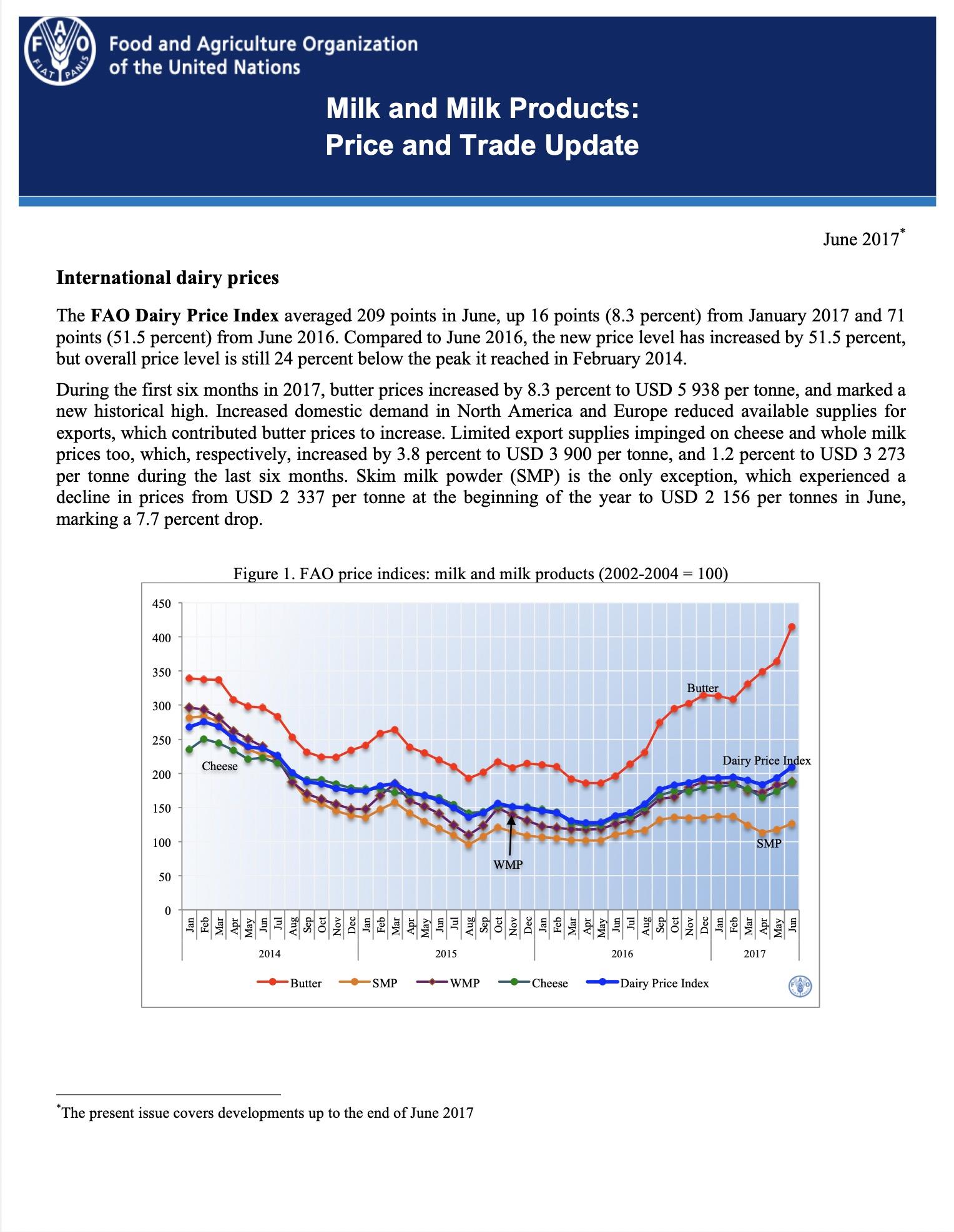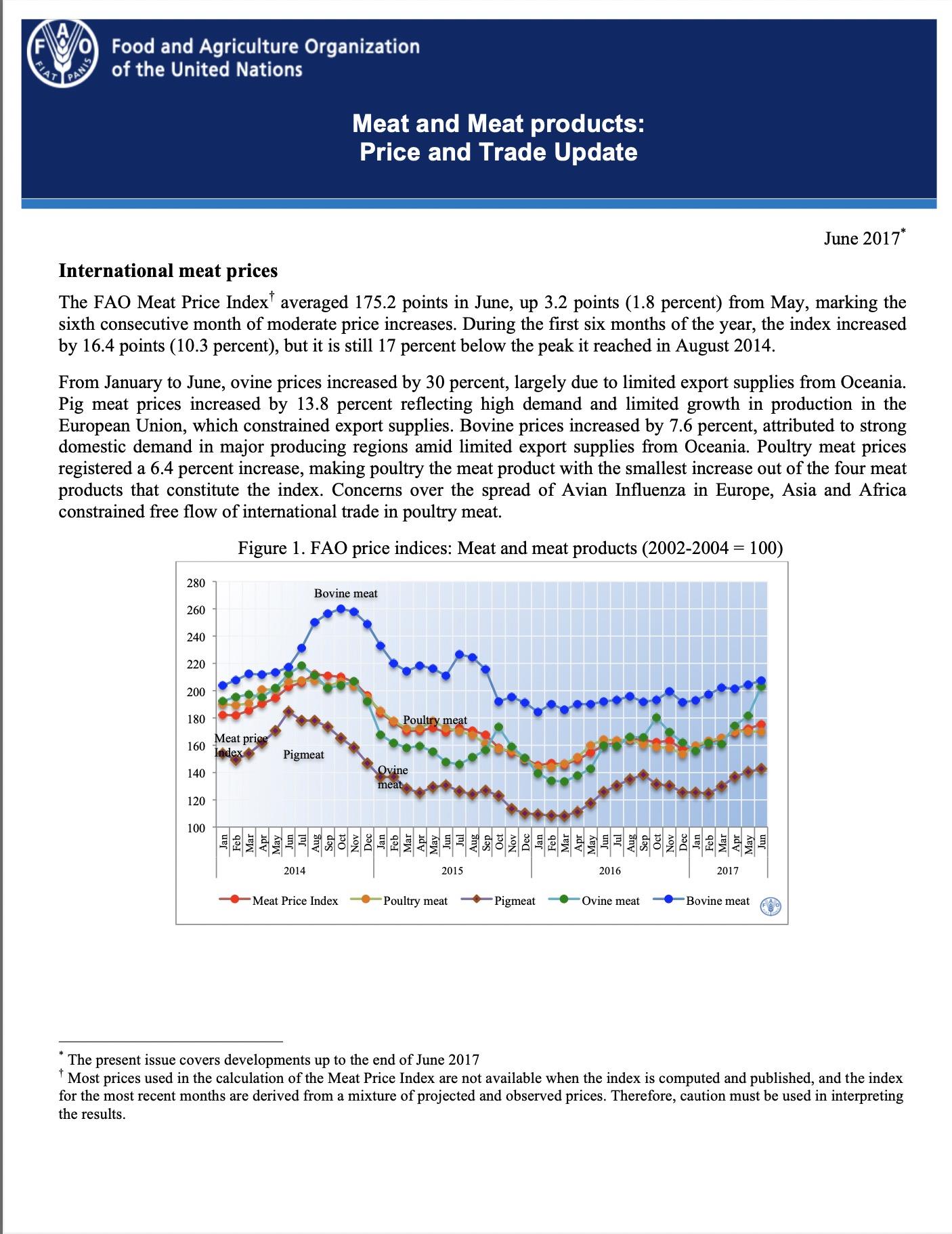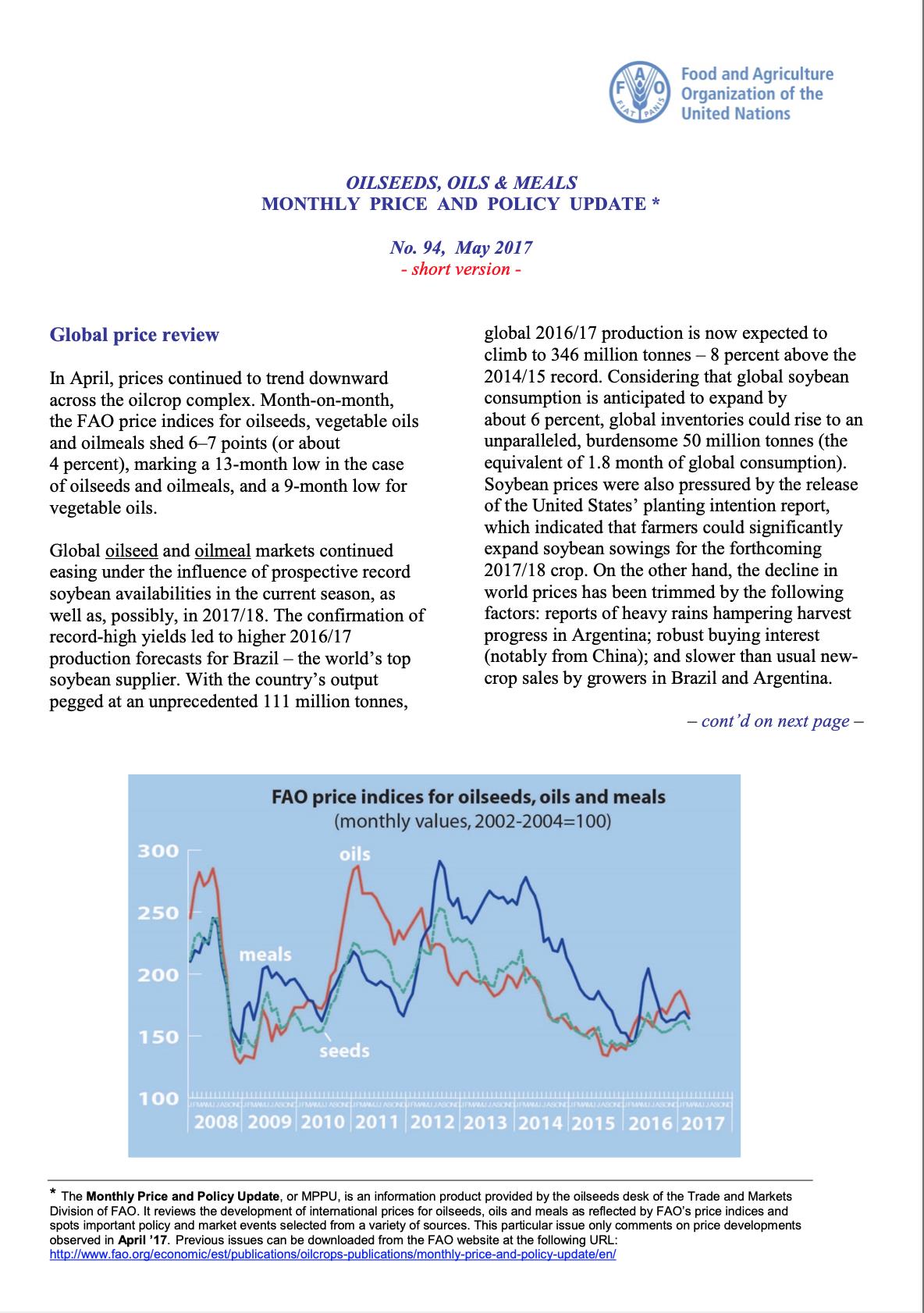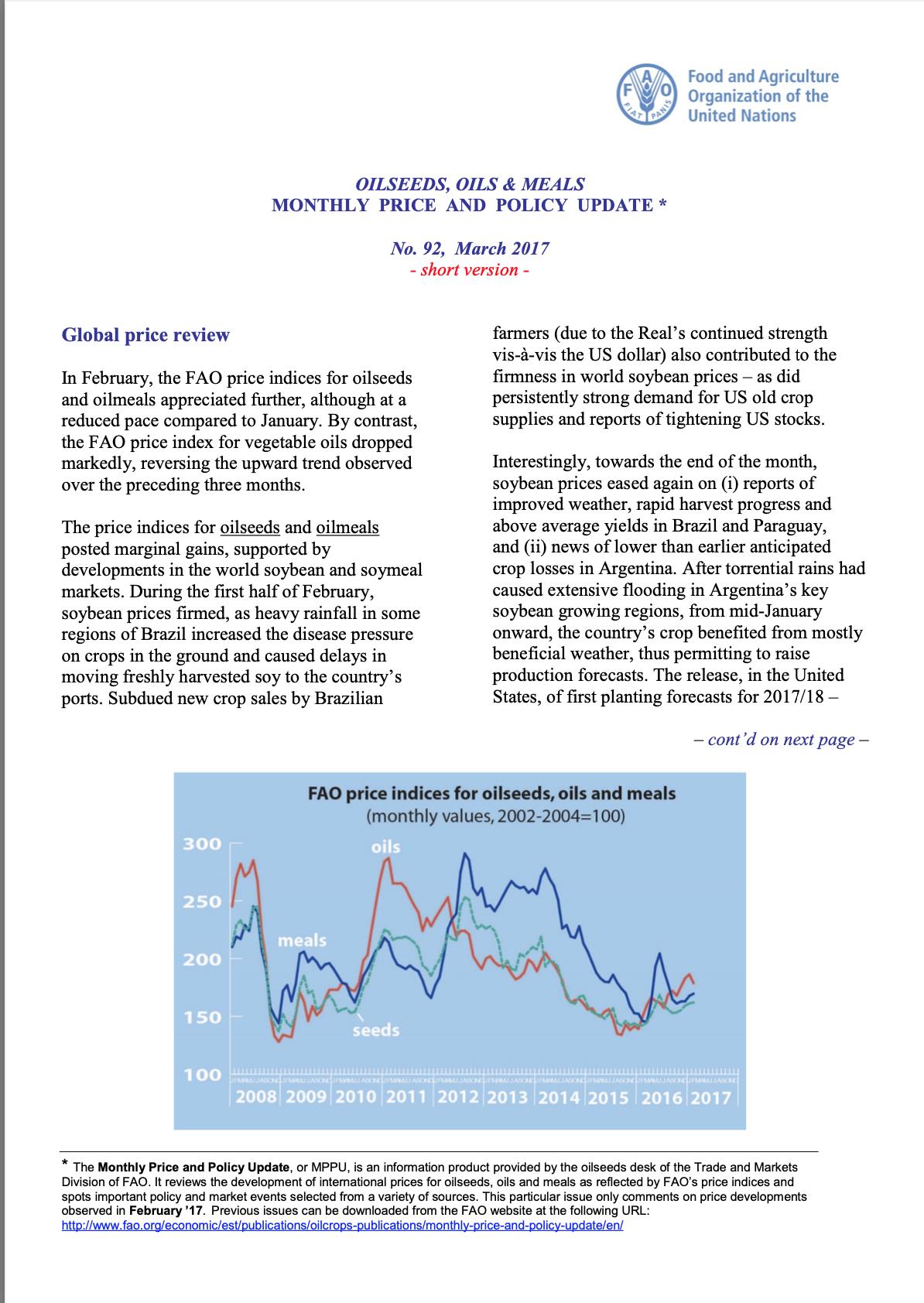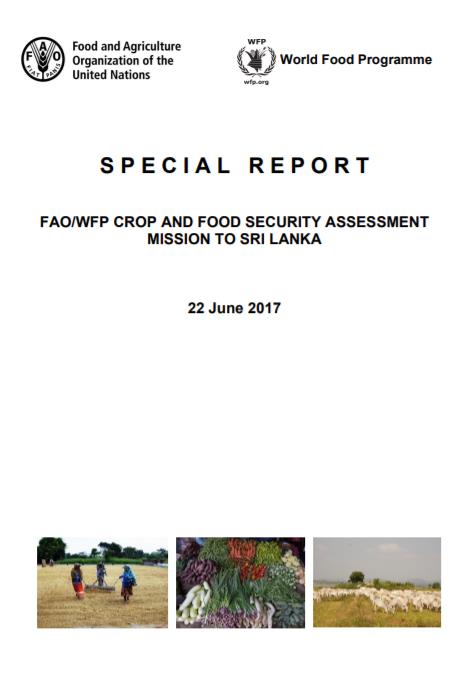
Special Report - FAO/WFP Crop and Food Security Assessment Mission to Sri Lanka
22/06/2017
An FAO/WFP Crop and Food Security Assessment Mission (CFSAM) visited Sri Lanka from 12 to 29 March 2017 at the request of the Ministry of Agriculture to estimate the 2016/17 main maha paddy production, to forecast the ongoing 2017 secondary yala paddy production and to analyse household food security conditions. The request was prompted by a prolonged period of poor rainfall over most of the country throughout 2016 that raised serious concerns on production of paddy and other crops in 2017 as we ll as on livestock. The Mission assessed the impact of the dry weather on the 2017 main-crop harvest and estimated the expected food deficit for 2017. The Mission assessed the overall food-security situation and identified the main country’s agricultural support needs until the next main harvest.
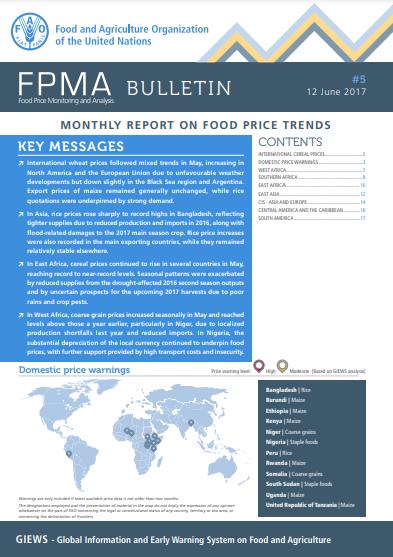
Food Price Monitoring and Analysis (FPMA) Bulletin #5, 12 June 2017
12/06/2017
International wheat prices followed mixed trends in May, increasing in North America and the European Union due to unfavourable weather developments but down slightly in the Black Sea region and Argentina. Export prices of maize remained generally unchanged, while rice quotations were underpinned by strong demand. In Asia, rice prices rose sharply to record highs in Bangladesh, reflecting tighter supplies due to reduced production and imports in 2016, along with flood‑related damages to the 2017 main season crop. Rice price increases were also recorded in the main exporting countries, while they remained relatively stable elsewhere. In East Africa, cereal prices continued to rise in several countries in May, reaching record to near-record levels. Seasonal patterns were exacerbated by reduced supplies from the drought-affected 2016 second season outputs and by uncertain prospects for the upcoming 2017 harvests due to poor rains and crop pests. In West Africa, coarse grain prices increased seasonally in May and reached levels above those a year earlier, particularly in Niger, due to localized production shortfalls last year and reduced imports. In Nigeria, the substantial depreciation of the local currency continued to underpin food prices, with further support provided by high transport costs and insecurity.
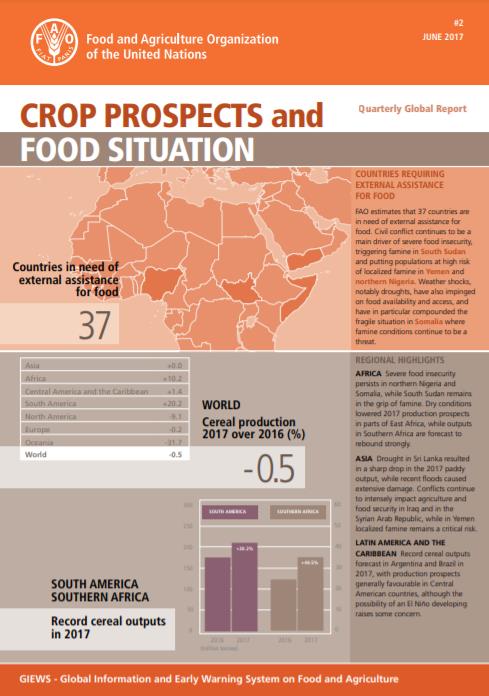
Crop Prospects and Food Situation - Quarterly Global Report, No. 2, June 2017
08/06/2017
FAO estimates that 37 countries are in need of external assistance for food. Civil conflict continues to be a main driver of severe food insecurity, triggering famine in South Sudan and putting populations at high risk of localized famine in Yemen and northern Nigeria. Weather shocks, notably droughts, have also impinged on food availability and access, and have in particular compounded the fragile situation in Somalia where famine conditions continue to be a threat.
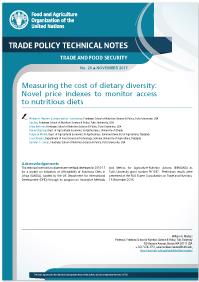
No. 20 Measuring the cost of dietary diversity
05/06/2017
This technical note describes a novel approach to measuring changes in the affordability of nutritious diets in low-income settings, using price indexes to monitor how trade policy or market infrastructure and other factors influence the cost of reaching a standard threshold of dietary diversity. We provide preliminary results for a new Cost of Diet Diversity (CoDD) price index in Ghana, contrasted with existing Cost of Nutrient Adequacy indexes as well as the standard Consumer Price Index concept for foods actually consumed, and world food price indexes for commodities that enter international trade.
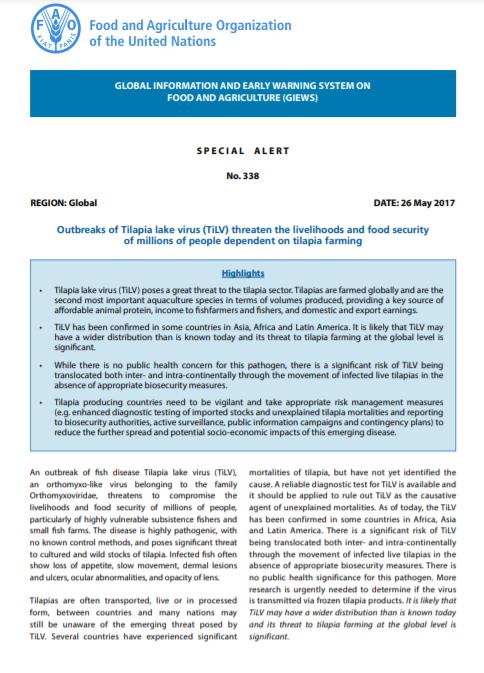
GIEWS - Special Alert No. 338 - Global, 26 May 2017
26/05/2017
Tilapia lake virus (TiLV) poses a great threat to the tilapia sector. Tilapias are farmed globally and are the second most important aquaculture species in terms of volumes produced, providing a key source of affordable animal protein, income to fishfarmers and fishers, and domestic and export earnings. TiLV has been confirmed in some countries in Asia, Africa and Latin America. It is likely that TiLV may have a wider distribution than is known today and its threat to tilapia farming at the gl obal level is significant. While there is no public health concern for this pathogen, there is a significant risk of TiLV being translocated both inter- and intra-continentally through the movement of infected live tilapias in the absence of appropriate biosecurity measures. Tilapia producing countries need to be vigilant and take appropriate risk management measures (e.g. enhanced diagnostic testing of imported stocks and unexplained tilapia mortalities and reporting to biosecurity authoriti es, active surveillance, public information campaigns and contingency plans) to reduce the further spread and potential socio-economic impacts of this emerging disease.
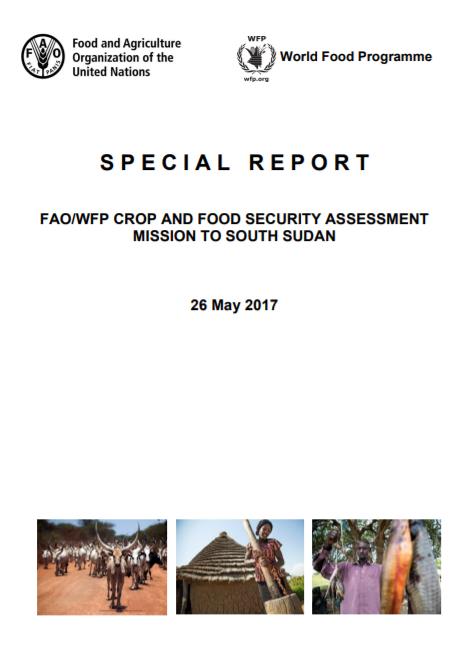
Special Report - FAO/WFP Crop and Food Security Assessment Mission to South Sudan - 26 May 2017
26/05/2017
An FAO/WFP Crop and Food Security Assessment Mission (CFSAM) visited South Sudan from 30 November to 12 December 2016 to estimate cereal production during 2016 and assess the overall food security situation. The CFSAM reviewed the findings of several crop assessment missions conducted at planting and harvest time in the different agro-ecological zones of the country from May to December 2016. As during 2014 and 2015, all assessment missions were carried out by a Task Force team that comprised s taff from the Ministry of Agriculture, Forestry, Cooperatives and Rural Development (MAFCRD), the National Bureau of Statistics (NBS) and FAO. Task Force team members have been trained during the last years to conduct rapid assessments using established protocols and techniques, such as driving and walking transects, scoring standing crops according to yield and livestock according to body condition, perform key informant interviews and farmer case studies. In addition, supported by the FAO AFIS project, twenty County Crop Monitoring Committees (CCMC) have been formed in 2016, with a view to extending the responsibility of collecting more objective data at local level.
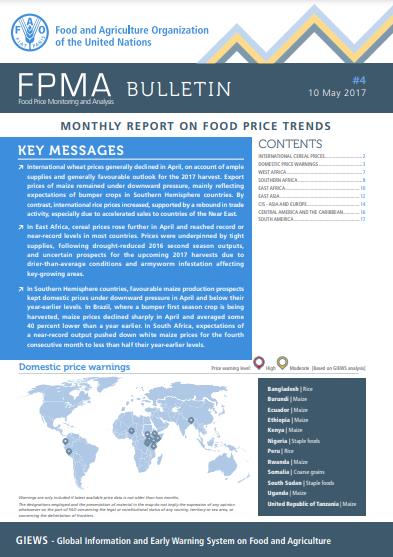
Food Price Monitoring and Analysis (FPMA) Bulletin #4, 10 May 2017
10/05/2017
International wheat prices generally declined in April, on account of ample supplies and generally favourable outlook for the 2017 harvest. Export prices of maize remained under downward pressure, mainly reflecting expectations of bumper crops in Southern Hemisphere countries. By contrast, international rice prices increased, supported by a rebound in trade activity, especially due to accelerated sales to countries of the Near East. In East Africa, cereal prices rose further in April and reached record or near‑record levels in most countries. Prices were underpinned by tight supplies, following drought-reduced 2016 second season outputs, and uncertain prospects for the upcoming 2017 harvests due to drier‑than‑average conditions and armyworm infestation affecting key‑growing areas. In Southern Hemisphere countries, favourable maize production prospects kept domestic prices under downward pressure in April and below their year-earlier levels. In Brazil, where a bumper first season crop is being harvested, maize prices declined sharply in April and averaged some 40 percent lower than a year earlier. In South Africa, expectations of a near‑record output pushed down white maize prices for the fourth consecutive month to less than half their year-earlier levels.
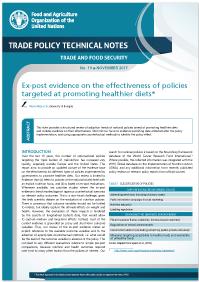
No. 19 Ex-post evidence on the effectiveness of policies targeted at promoting healthier diets
09/05/2017
This note provides a structured review of adoption trends of national policies aimed at promoting healthier diets and collates evidence on their effectiveness. We limit our focus to evidence exploiting data collected after the policy implementation, and using appropriate counterfactual methods to identify the policy effect.
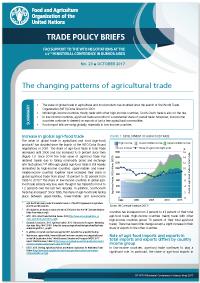
No. 23 The changing patterns of agricultural trade
09/05/2017
This brief describes trends in agri-food trade globally and by country income group with a focus on trade patterns of low-income countries.

No. 18 The influence of agricultural, trade and food policies on diets
12/04/2017
Traditionally, agricultural, trade and food policies have rarely been shaped by their anticipated dietary and nutritional impacts. Yet, such policy choices have potentially important consequences for the diets and nutrition of populations.This note presents an overview of dietary implications of agri-food policies not explicitly targeted at nutrition.

No. 22 Agricultural markets: trends and outlook
11/04/2017
This brief discusses the major trends and prospects in agricultural production, consumption, trade and prices based on the OECD-FAO Agricultural Outlook 2017-2026.
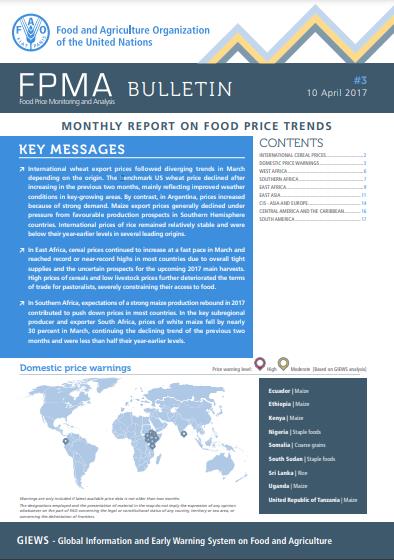
Food Price Monitoring and Analysis (FPMA) Bulletin #3, 10 April 2017
10/04/2017
International wheat export prices followed diverging trends in March depending on the origin. The benchmark US wheat price declined after increasing in the previous two months, mainly reflecting improved weather conditions in key-growing areas. By contrast, in Argentina, prices increased because of strong demand. Maize export prices generally declined under pressure from favourable production prospects in Southern Hemisphere countries. International prices of rice remained relatively stable and were below their year-earlier levels in several leading origins. In East Africa, cereal prices continued to increase at a fast pace in March and reached record or near-record highs in most countries due to overall tight supplies and the uncertain prospects for the upcoming 2017 main harvests. High prices of cereals and low livestock prices further deteriorated the terms of trade for pastoralists, severely constraining their access to food. In Southern Africa, expectations of a strong maize production rebound in 2017 contributed to push down prices in most countries. In the key subregional producer and exporter South Africa, prices of white maize fell by nearly 30 percent in March, continuing the declining trend of the previous two months and were less than half their year-earlier levels.
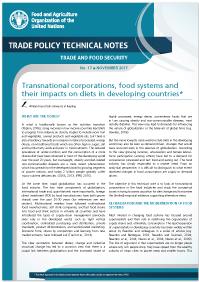
No. 17 Transnational corporations, food systems and their impacts on diets in developing countries
14/03/2017
The objective in this technical note is to look at transnational corporations in the food industries and study the conceptual issues in trying to assess causation for diet change and to examine the (limited) empirical evidence supporting alternative views.
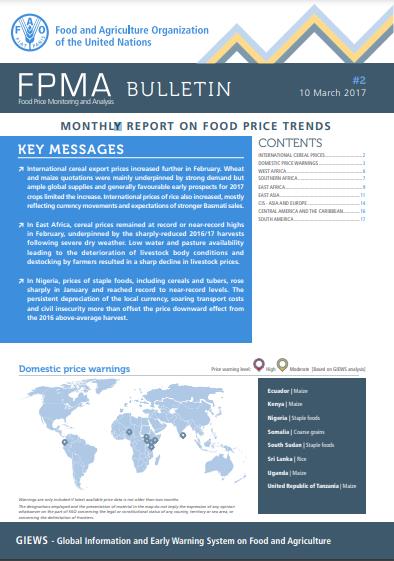
Food Price Monitoring and Analysis (FPMA) Bulletin #2, 10 March 2017
10/03/2017
International cereal export prices increased further in February. Wheat and maize quotations were mainly underpinned by strong demand but ample global supplies and generally favourable early prospects for 2017 crops limited the increase. International prices of rice also increased, mostly reflecting currency movements and expectations of stronger Basmati sales. In East Africa, cereal prices remained at record or near-record highs in February, underpinned by the sharply-reduced 2016/17 harvests following severe dry weather. Low water and pasture availability leading to the deterioration of livestock body conditions and destocking by farmers resulted in a sharp decline in livestock prices. In Nigeria, prices of staple foods, including cereals and tubers, rose sharply in January and reached record to near-record levels. The persistent depreciation of the local currency, soaring transport costs and civil insecurity more than offset the price downward effect from the 2016 above-average harvest.

